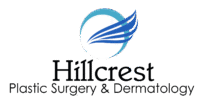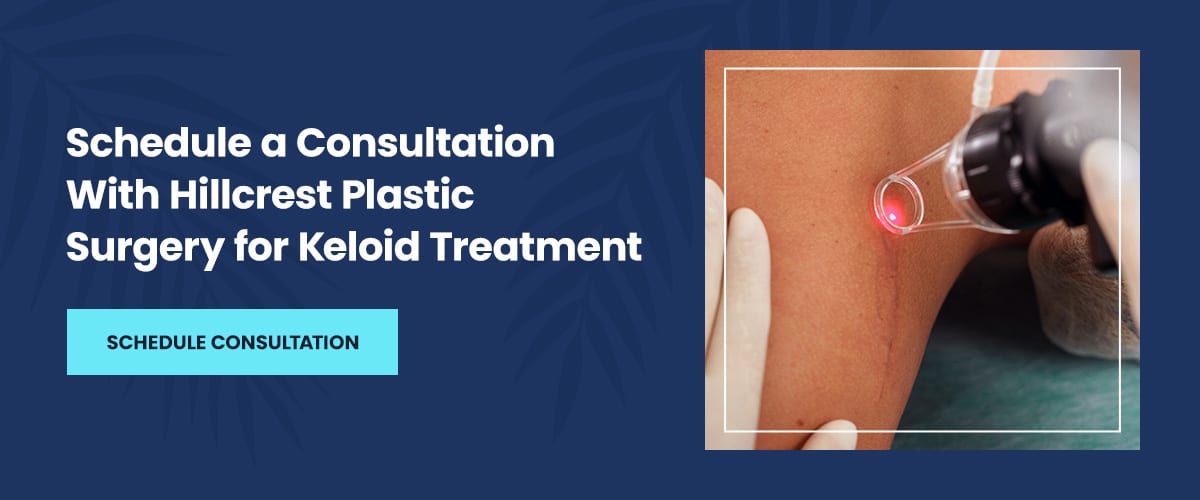Keloid Treatment Options
If you have a stubborn scar that’s itchy, painful or seems to grow beyond the original wound, you may be dealing with a keloid. These raised, thickened scars form when your skin heals after an injury, often outgrowing the original wound. While they’re not harmful, they can cause discomfort and affect your confidence.
Luckily, there are treatment options available to help reduce their size and discomfort. Finding the right treatment for you depends on your needs, including your skin type and keloid severity.
What are Keloids?
Keloids are benign dermal fibroproliferative tumors with no malignant potential. This abnormal scar tissue forms at the site of skin injury. Keloids do not regress but rather grow beyond the original margins of the scar. They differ from hypertrophic scars, which do not grow beyond the boundaries of the original wound and can be reduced over time.
Who Can Get Keloids?
While anyone can develop keloids, some people are more prone to them. They occur in 10% of people, and individuals with highly pigmented skin are more likely to develop them. Genetics may also play a role. Keloids can form after any type of skin injury, including cuts, surgery or acne. Understanding your risk factors can help you take preventive steps if you’re prone to keloid scarring.
What Can Cause Keloids?
While it is not entirely clear what causes keloids, many cellular-level responses may contribute to them. They often form after skin injuries like:
- Surgical incisions: Scars from surgeries can grow into keloids as the body produces excess collagen during the healing process.
- Burns and cuts: Even minor wounds can lead to keloids in people prone to them.
- Tattoos and piercings: These can trigger keloid formation, especially on the ears and chest.
- Acne and chickenpox scars: Inflammatory skin conditions can leave keloid scarring.
- Vaccination sites: Some individuals develop keloids at injection sites.
Research into their causes and treatments continues to evolve. At Hillcrest Plastic Surgery, we keep abreast of all new developments so we can offer the best keloid scar treatments available.
What Is the Best Treatment for Keloid Scars?
While there are several keloid treatment options, a combination is the best approach. At Hillcrest Plastic Surgery, we take an effective multidisciplinary approach, combining the expertise of plastic surgeons and dermatologists to ensure a higher success rate in treating keloids and preventing their recurrence. At your consultation, we will review your history and come up with a plan that best suits you.
Superficial Radiation
One of the most effective treatments to prevent keloid recurrence is superficial radiation therapy, especially when combined with surgical excision. Studies show this approach only has a 20% recurrence rate.
After removing the keloid, you would undergo just three painless radiation sessions, lasting five minutes each, with no painful injections. However, there are possible side effects, including hyperpigmentation and telangiectasia — small, widened blood vessels near the skin’s surface.
Compression Dressings
Mechanical compression dressings are custom-made and most effective if you wear them 24 hours a day. Pressure devices include Dacron spandex bobbinet fabric, support bandages, or zinc oxide adhesive plaster.
Earlobe devices are available for keloids resulting from ear piercings. The recommended level of pressure is 25 mm Hg, but good results have been observed with pressures as low as 5-15 mm Hg. These dressings affect the keloid at a cellular level by occluding small vessels and reducing oxygen tension in the wound.
Occlusive Dressings
Occlusive dressings are a proven option for treating keloids with varied results. You can wear occlusive dressings and silicone gel sheets for as many as 24 hours a day over several months to a year to help flatten and soften the scar tissue. Studies show that patients experienced a 90% improvement in keloid scars with less scar elevation, redness and itching, although complete removal hasn’t been recorded.
Corticosteroids
Steroid injections into the keloid have been used with some effectiveness for years. These injections decrease dermal thickening. You can use steroids by themselves or in combination with other therapies, including excision. They can be injected before surgery to decrease the size and then continued after surgery. Some side effects of corticosteroid injections include atrophy of the subcutaneous tissue and hypopigmentation. Most of these adverse effects can be avoided by injecting as few infusions as possible while still remaining effective at treating the keloid.
Excisional Surgery
Surgical removal or excisional surgery is one of the most common keloid treatments. It involves carefully cutting out the keloid to reduce its size and improve the skin’s appearance. We do not recommend excision alone due to such high recurrence rates. We often combine it with treatments like superficial radiation, corticosteroid injections, or silicon dressings to prevent recurrence. The goal is removing the keloid and minimizing the chances of it returning.
Cryosurgery
Cryotherapy uses liquid nitrogen to cause cell damage and to affect the tiny blood vessels, causing the blood vessels to clot and thus decreasing oxygen delivery to the keloid. Unfortunately, there may be side effects, which include pain and depigmentation. Cryotherapy used in combination with steroid injections has an even greater response rate.
Laser Therapy
Laser therapy by itself is not a very efficacious way of treating keloids. It is used as a multi-treatment modality to decrease the recurrence of keloids. It destroys the tiny vessels in the keloid scar, thus reducing keloid recurrence.
Interferon Therapy
This therapy involves intralesional injection of a drug called Interferon, which reduces keloid-causing substances at the cellular level. This is also done in combination with excisional surgery.
5-Fluoruracil Therapy
This therapy involves injecting the keloid with a drug used to treat skin cancers — 5-fluorouracil. While this therapy effectively decreases recurrence, combining it with steroid injections can improve the results.
Imiquimod Therapy
Imiquimod is a cream that is placed on the keloid site after excision to decrease the rate of keloid recurrence. It is normally used to treat skin cancer. A side effect of this treatment is hyperpigmentation.
Why Choose Hillcrest Plastic Surgery for Keloid Treatment?
At Hillcrest Plastic Surgery, we take a comprehensive, multidisciplinary approach to keloid treatment, offering advanced care that sets us apart. We are the only facility in the state of Florida offering such a comprehensive range of keloid treatments for truly coordinated care. We don’t just remove keloids — we focus on the most effective keloid treatment for you specifically to prevent recurrence and improve your skin’s appearance.
Here’s why patients trust us:
- Specialized expertise: Our team includes board-certified plastic surgeons and dermatologists working together to create customized treatment plans. This collaborative approach ensures the best possible outcomes compared to single-disciplinary approaches.
- Various treatment options: Successful keloid treatment requires a full spectrum of methods, and we offer them all under one roof, including superficial radiation therapy, laser treatment, cryotherapy and advanced drug therapies.
- Advanced technology: Our practice is equipped with cutting-edge tools like the SRT-100 radiation machine, which has been shown to contribute to a significant reduction in keloid recurrence when used alongside other therapies.
- Surgical precision: Our renowned plastic surgeons use advanced incision and closure techniques to minimize scarring and enhance cosmetic results.
What Should You Bring to Your Consultation?
An essential first step in your keloid treatment is your initial consultation. This gives us a chance to meet you and evaluate your needs to provide a personalized treatment plan.
Here’s what to bring along:
- Your medical history
- Current medications
- Past surgery history
If you have had treatment of keloids by other physicians, please bring in a history of the treatments. We can develop a treatment plan based on what has and has not worked for you in the past.
Schedule a Consultation With Hillcrest Plastic Surgery for Keloid Treatment
We are committed to providing personalized and effective care for your keloid treatment. Our expert team is here to guide you through every step of your treatment journey, from initial consultation to recovery. Schedule a consultation with us today, or contact us to learn more.




